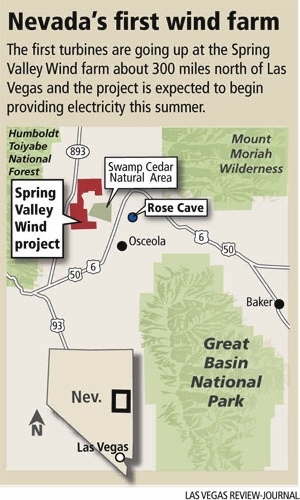Wind energy project gearing up after lawsuit settled

An environmental lawsuit has been settled, and the turbines are going up at Nevada’s first wind energy project, about 300 miles north of Las Vegas.
The Spring Valley Wind farm in White Pine County, west of Great Basin National Park, is set to start powering lights and air conditioners in Northern Nevada this July.
The $225 million project by San Francisco-based Pattern Energy will use 66 turbines – each roughly the height of a 30-story building – to generate 150 megawatts of electricity, enough to supply about 45,000 homes.
NV Energy has agreed to buy power from the wind farm for the next 20 years.
The Western Watersheds Project and the Center for Biological Diversity tried to block the project in January 2011 with a lawsuit accusing the U.S. Bureau of Land Management of skirting environmental regulations to fast-track the wind farm.
The lawsuit noted that the project was approved over concerns from the National Park Service and biologists from the U.S. Fish and Wildlife Service and the Nevada Department of Wildlife.
The two sides entered settlement talks last year after a federal judge refused to stop work at the site to allow more study of how the windmills might impact bats and sage grouse in the area.
Under the settlement, approved March 29 by a federal district court in Nevada, Pattern agreed to expand its program for tracking bird and bat deaths associated with the project.
The company also will pay $50,000 for a study of nearby Rose Cave, where more than 1 million Mexican free-tailed bats roost during their fall migration.
But environmentalists still aren’t happy with the arrangement.
Rob Mrowka is Nevada public lands conservation advocate for the Arizona-based Center for Biological Diversity. He said they were forced to settle and try to get as much mitigation as they could once the judge in the case denied a motion to halt construction.
Mrowka said the site is riddled with problems, including its proximity to Rose Cave and to known nesting and brood-raising areas for sage grouse. The wind farm also abuts a sacred Western Shoshone swamp cedar site where Indians were massacred during the Goshute War of 1863.
“It’s just a bad spot,” Mrowka said. “The bad stuff just goes on and on.”
Pattern officials defend the site, which has been the subject of wind and weather monitoring since 2005.
“We are starting to see that all renewable energy projects, no matter how well-planned, are being questioned,” said Pattern CEO Mike Garland in a statement Tuesday. “The settlement should give more confidence to these concerned parties and the community that the project is well-designed.”
In 2010, planners said they expected fewer than 203 birds and 193 bats to die from turbine encounters each year.
The first few turbine towers are being erected near the heart of the vast Spring Valley, which runs north-south for about 110 miles between the Schell Creek and Snake mountain ranges in eastern Nevada.
Each 262-foot tower will hold a rotor with three blades the length of a football field.
Biologists think as many as 3 million Mexican free-tailed bats roost in Rose Cave, about five miles from the wind farm, for one to three days while on their southern migration to Central America from late July through early October. At peak times in August as many as 2,000 bats per minute have been counted leaving the cave, where guano was mined in the 1930s for use in fertilizer and possibly gunpowder.
The wind farm will cover 7,500 acres of public land, though its actual footprint only takes up about 2 percent of that area. The rest of the property will remain open to hunting, hiking and cattle grazing, Pattern spokesman Matt Dallas said.
Early on, the turbines will serve only NV Energy customers in Northern Nevada. The power eventually will find its way south to the Las Vegas Valley with the completion of a new transmission line now being built from Ely to Apex.
Spring Valley Wind will be Pattern’s fourth operating wind project in North America and one of several wind farms the company expects to bring into operation this year.
Contact reporter Henry Brean at hbrean@reviewjournal.com or 702-383-0350.












